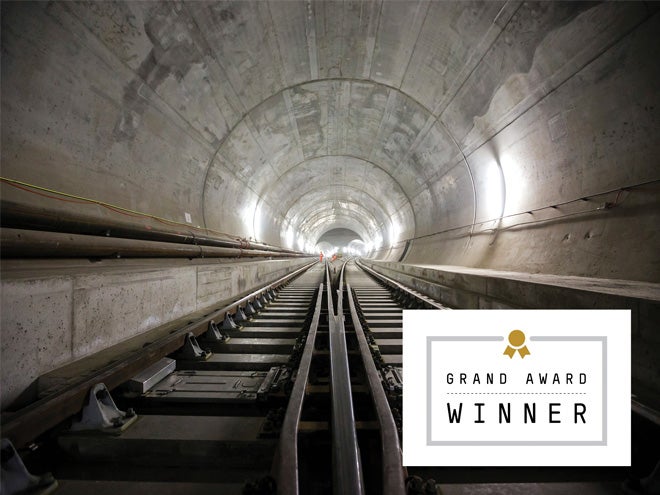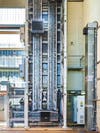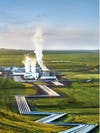Foster + Partners’ Zayed National Museum: Underground Oasis
To beat the heat in the United Arab Emirates, this museum’s galleries will be subterranean. Meanwhile, towers inspired by falcon wings will allow rising hot air to escape, while drawing cooler air into the structure.
Mack Rides Pulsar: Next-Level Waterpark
Artificial log flumes in theme parks are so yesteryear. So, a German ride-design firm has brought the waterworks to a natural setting. They drained (then refilled) a lake to lay the foundation for a U-shaped roller coaster that rockets into the water at 60 miles per hour, creating a tsunami-like wave that drenches riders. Thrill-seekers swoop through the U twice before the force of the splash slows down the car.
Gensler’s Shanghai Tower: An Extra-Green Skyscraper
The bigger the building, the harder it gets to efficiently heat and cool the interior. So architects gave the world’s second-tallest skyscraper, which opened this year in Shanghai, a double-walled facade that “acts as a thermos, keeping occupants warm in the winter and cool in the summer,” according to project director Grant Uhlir. The twisty shape creates room for 21 “sky gardens” that reflect the natural landscape and purify the internal air.
Penn State CRISPR-Cas9 for Food: ‘Shrooms with Shelf-Life
Up to 40 percent of food in the U.S. goes to waste, often due to spoilage. A plant pathologist at Penn State used the versatile gene-editing tool called CRISPR-Cas9 to design a button mushroom that resists browning, might have a longer shelf life, and could ultimately cost the same as regular old ’shrooms. Though the product is not yet on sale, the tech behind it skirted USDA regulation last spring, paving the way for future gene-edited groceries.
ThyssenKrupp MULTI Elevator: Elevators That Go in Any Direction
Elevator shafts often take up half of a skyscraper’s footprint, and the steel cables that carry them up and down limit how high the cars can travel. These constraints can be a major buzzkill for forward-thinking architects, who might want to design taller and wider. Enter MULTI, an elevator system that levitates—vertically, horizontally, and diagonally—atop tracks embedded with powerful magnets. Scheduled to begin testing in Germany early next year, MULTI will allow for indefinitely taller, wider, and more creatively designed towers.
Columbia + Univ. of Iceland: CarbFix, A Speedy Way to Store C02
Capturing carbon from the atmosphere is an alluring solution to our climate woes, but we need to figure out how to store it quickly and permanently. CarbFix
—a system currently in use at one power plant in Iceland—dissolves greenhouse gases in water, and then pumps them into nearby basalt-laden volcanic rock, where both convert into limestone within a few years. The ocean floor is rich in basalt, so the method could scale worldwide.
MIT + Caltech: Advanced LIGO, A Microphone for the Universe
LIGO, or the Laser Interferometer Gravitational-Wave Observatory, first ran a decade ago to detect gravitational waves—ripples in spacetime, some of which date to the Big Bang. This year, an upgraded system called Advanced LIGO, which is much more sensitive, confirmed one of Einstein’s biggest predictions—on its first run. Observing these waves lets scientists plot the history of the universe and spot events like supernovas.
TEB Technology Transit Elevated Bus: Traffic-Straddling Bus
It remains to be seen if China’s straddling bus—which scoots over the same roadways as cars, on tracks embedded in the pavement—is practical. But it’s a bold idea for cities congested with traffic and pollution.
Harvard Robotic Stingray: The First Cyborg Animal
Biologists want to make artificial organs. But to do that, they need a deep understanding of how muscle cells—like those in the heart—talk to one another. So scientists at Harvard created the first truly hybrid robot animal. The nickel-size stingray has a gold skeleton covered in a stretchy polymer to which rat muscle cells are attached. Pulsing light makes the ray “swim.” It could help us learn how to build a heart that’s half-muscle, half-machine.
M. Ludvik SkySlide: Quake-Proof Glass
A slide that hovers 1,000 feet above Los Angeles might seem like mere novelty, but the process used to make the glass could lead to stronger, more energy-efficient buildings. Architects used code from NASA to structurally analyze the design, then employed a new form of chemical strengthening to make glass that’s as strong as steel. “We could create naturally lit structures with very low carbon footprints,” says SkySlide engineer Michael Ludvik.
Read about the other Best of What’s New winners from the November/December 2016 issue of Popular Science.










